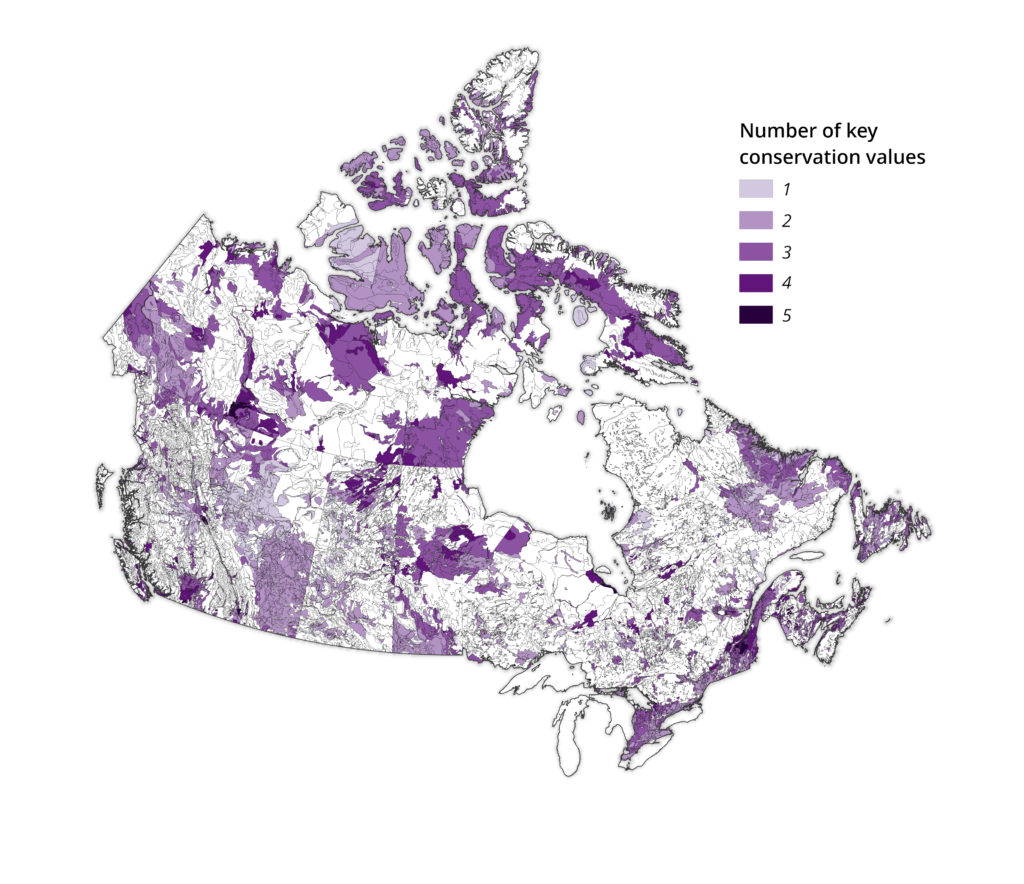WWF-Canada calls for a new model for creating protected areas to meet international commitments in countdown to COP15
Toronto, ON — As world leaders gather today at the UN General Assembly to secure ambitious goals for climate and biodiversity negotiations this fall, a report from WWF-Canada outlines the need for a new model for protected area establishment in Canada — one that protects the right areas, in the right ways, for the right reasons.
In order for Canada to meet its international commitments to reduce carbon emissions and reverse biodiversity loss, a protected areas network of the future should act as a nature-based climate solution by providing habitat for wildlife and storing and sequestering carbon. Past approaches to protected areas establishment have focused on setting aside areas on a map, without consideration of how they ladder up to a larger, future-proof network, and without prioritizing Indigenous rights and title. WWF-Canada’s Beyond Targets report shows how this approach has left gaps of ecological representation (e.g., size, connectivity and quality) in our protected areas network, at a time when urgent action is needed to reduce emissions and reverse wildlife loss.
The creation of new protected areas in Canada must advance Indigenous rights and title, as well as consider four other factors: the location of species at risk, connectivity of protected areas, climate resiliency and carbon storage.
After identifying gaps in the current protected areas network, WWF-Canada’s new analysis evaluated these four factors and identified areas of high conservation value across Canada that, if protected, can deliver effective nature-based climate solutions and help meet our international biodiversity and climate commitments. The results of the analysis are presented alongside interviews with four Indigenous conservation leaders, who share their expertise working to protect important places across the country. A combination of “Western” science and Indigenous knowledge is crucial if we are going to meet our national and international targets in an ethical and rights-driven way.

Key takeaways:
- As international governments move toward a post-2020 Global Biodiversity Framework that aims to reverse biodiversity loss by 2030, protected areas will play an increasingly significant role in achieving both national and international biodiversity and climate goals.
- There are fewer natural areas remaining in the south (the provinces) because of current and historical higher human footprint, which means that protection will have to be accompanied by restoration of degraded or destroyed landscapes.
- In the north (the territories in this assessment), there are large swaths of unprotected natural areas that provide opportunities for advancing community-led conservation.
- Protected areas networks need to be reimagined to gain maximum positive impact for biodiversity, climate, and Indigenous rights and governance structures.
Quotes:
“We now know that protected areas can reverse biodiversity loss by protecting critical habitats, reduce carbon emissions by keeping carbon stored in nature, and advance Indigenous rights and title by supporting Indigenous Protected and Conserved Areas, but none of those things will happen without a holistic, co-ordinated and rights-driven plan. If we want to meet our international commitments to biodiversity loss and climate change, we need a new approach to prioritizing protections of the right places in the right ways.” – James Snider, VP, Science, Knowledge & Innovation, WWF-Canada
“Indigenous Protected and Conserved Areas (IPCAs) are the only hope we have. If Canada wants to achieve its commitment to protect biodiversity, by conserving 30 per cent of land and inland waters and marine and coastal areas by 2030, it needs Indigenous involvement. If Canada wants to achieve reconciliation — whether that’s land reconciliation, financial reconciliation, cultural reconciliation or knowledge reconciliation — and some semblance of land back, Indigenous people need to be involved.” – Steven Nitah, Łutsël K’é Dene First Nation
Next Steps
Protected area establishment in Canada cannot continue under a “business-as-usual” approach. The dual crises of biodiversity loss and climate change demand that new protected areas deal with both at the same, and our responsibility to advance reconciliation demands the prioritization of Indigenous rights and title. This is why we need a new model.
The new model should:
- Consider connectivity, ecological representation, climate refuges, carbon storage and Indigenous rights and title, all while incorporating strategies for long-term management and stewardship.
- Prioritize Indigenous Protected and Conserved Areas (IPCAs). Non-IPCAs should be co-developed and implemented with Indigenous consent, recognition of territorial rights and title, and incorporation of Indigenous knowledge systems, leadership and stewardship.
- Establish and define emissions reduction targets for protected areas, and include them in the Government of Canada’s Naturally Determined Contributions (NDCs).
- Create new financial tools that account for the establishment, management and long-term stewardship of protected areas so that they can provide prolonged benefits for biodiversity and climate in the centuries to come.
- Develop new legislative tools to advance IPCAs where current protected areas establishment tools are limited — as identified by the Indigenous Circle of Experts during the Pathway to Target 1 process. Crown governments must also recognize and support IPCAs when unilaterally declared by Indigenous Nations in acknowledgment of self-determination and self-governance.
About World Wildlife Fund Canada
WWF-Canada is committed to equitable and effective conservation actions that restore nature, reverse wildlife loss and fight climate change. We draw on scientific analysis and Indigenous guidance to ensure all our efforts connect to a single goal: a future where wildlife, nature and people thrive. For more information visit wwf.ca.
For more information or to arrange an interview, please contact media@wwfcanada.org
